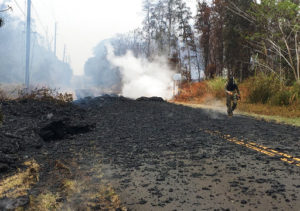

Hawaii’s insurance commissioner has made it clear that homes destroyed or damaged in the recent lava flow into a Hawaii neighborhood are covered for the damage under homeowners insurance policies.
Gordon Ito, who has been the state’s insurance commissioner since 2010 and is chair of the National Association of Insurance Commissioners Western zone, said his department doesn’t currently have an estimate on insured losses but does estimate that about 25 single family homes as well as other structures have been destroyed by the lava flow.
“We’re talking about 35 structures,” Ito said, adding to that total non-residential properties that were affected.
Ito’s office has now said that not all homes may be covered. See an updated story for more on that: Hawaii Insurance Agent Helping Clients with Lava Claims Say Some May Not be Covered
However, there are almost 1,000 homes in the high risk area, according to a catastrophe risk modeling firm CoreLogic.
Kilauea, Hawaii’s most active volcano, erupted on Thursday. Ensuing lava flows forced the evacuation of roughly 2,000 residents.
As of late afternoon on Tuesday the lava flows had ceased, however the United States Geological Survey is warning the risk is still present.
“There’s still magma moving around underground,” Ito said.
Hawaii Residents Alerted to Toxic Gas from Eruption, New Areas At Risk
Ito said his office hasn’t fielded any complaints from policyholders about insurance claims. Part of that is because in Hawaii if a home is destroyed by lava flow, that’s considered fire damage, and the losses and damages to all properties so far have been from lava flow, he said.
“For the most part if you have a homeowners fire policy, if your home catches fire and burns down, then it’s covered under the fire loss,” Ito said. “Through the years that’s been our policy.”
In 2014 a similar event occurred in which lava was coming out of crater and headed toward Pahoa. In that instance a handful of homes were lost, but no one had their claims denied, he added.
The lava flow that began on Thursday is from a new fissure that opened up nearby.
The eruption of Hawaii’s Kilauea volcano could actually intensify in coming weeks, the USGS said on Wednesday.

There are numerous homes that could be affected by more lava flow, or if more violent eruptions were to shoot blocks of lava out into the air.
A wide area could be potentially impacted by the thermal region outlined by the USGS as a high danger zone, according to Maiclaire Bolton-Smith, senior leader of research and content strategy for Irvine, Calif.-based catastrophe modeler CoreLogic.
“About a thousand properties are in the high-risk area,” Bolton-Smith said.
There are roughly 5,900 homes in the broader area that could be at some level of risk, she added.
An added risk comes from potential earthquakes, said Bolton-Smith, a seismologist. A magnitude 6.9 earthquake struck on Friday, the largest recorded quake on the islands since 1975, she said. The earthquake was centered in a remote area without much exposure, she added.
Patrick Wraight, director of Insurance Journal’s Academy of Insurance, noted that a volcanic eruption is a peril that does not include loss caused by earthquake, land shock waves or tremors.
“There’s no coverage for the initial eruption, unless the property is damaged by the lava flow, or there is a fire after the eruption – fire is a covered peril,” Wraight said.
Additional coverage for debris removal also speaks to coverage for volcanic eruption, he added.
“If the debris can be traced back to a covered peril, the debris removal additional coverage will pay some money to get rid of the damaged property and the volcanic ash,” he said.
Kilauea is an active shield volcano that’s been erupting on and off for tens of thousands of years. Hawaii’s Big Island has five shield volcanoes, which are associated more with lava flows than their explosive, ash-spewing stratovolcano cousins, according to Bolton-Smith.
The activity tied to the current lava flows has been ongoing for decades.
“This current eruption started in 1983,” she said.
Related: